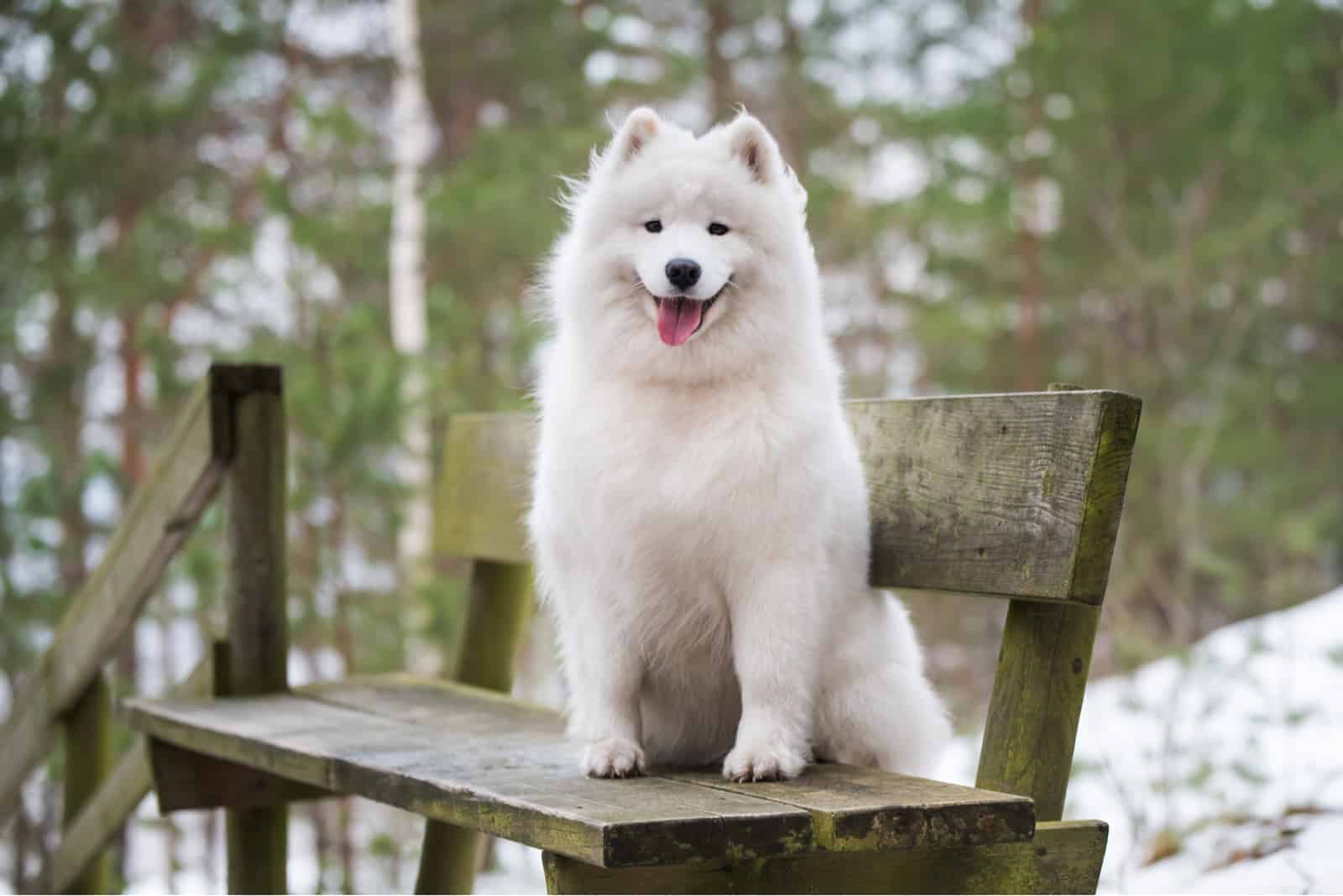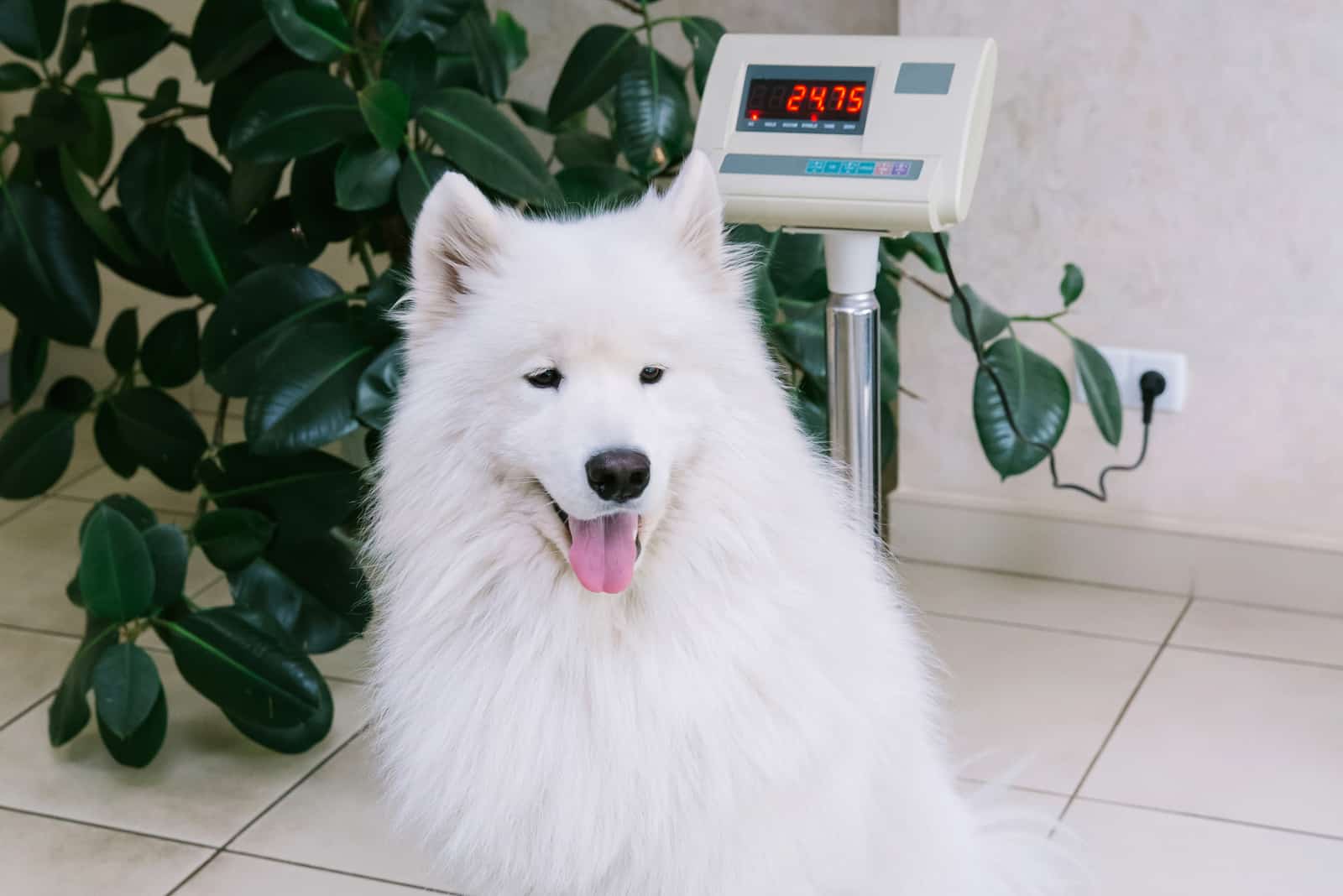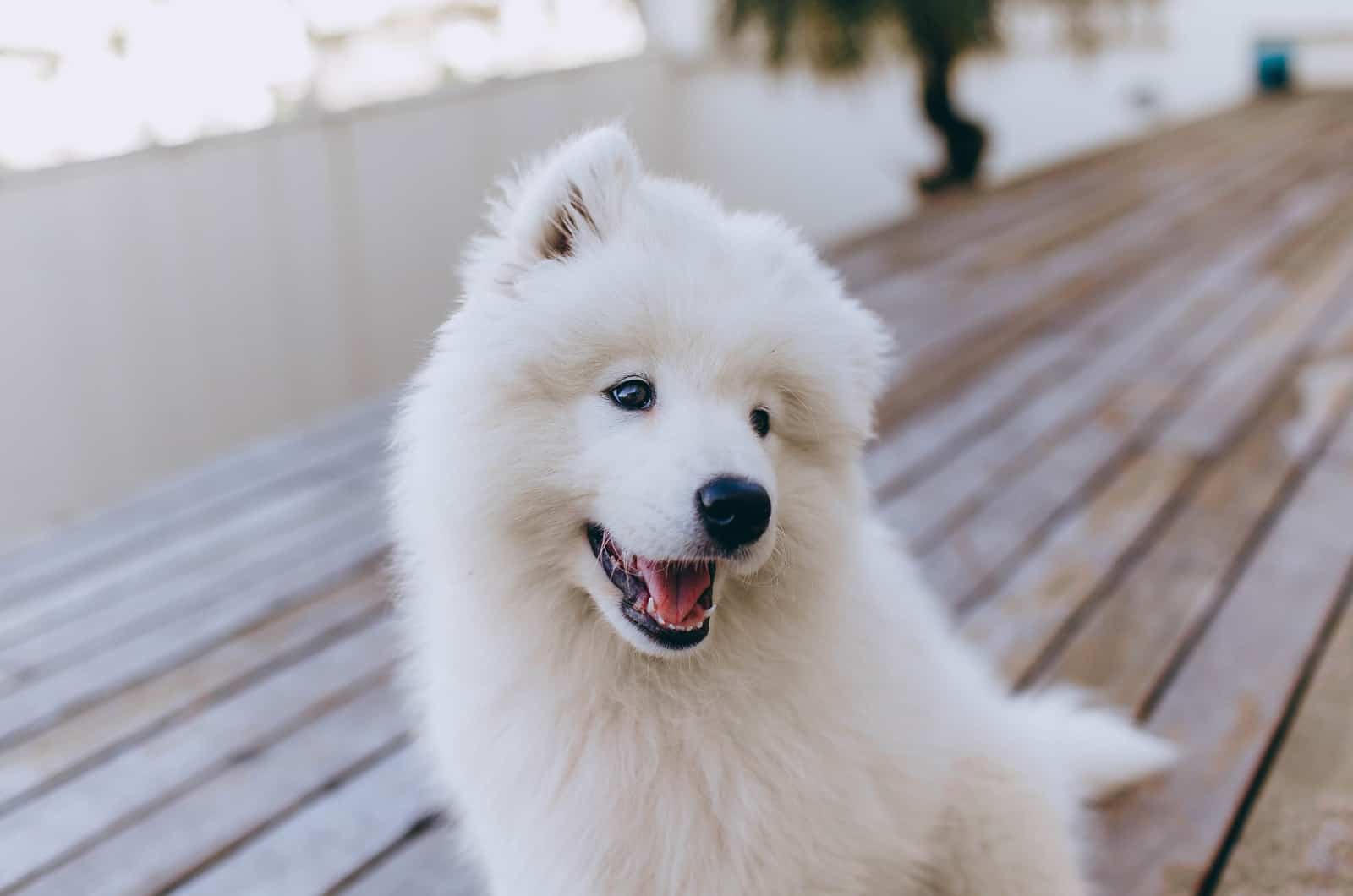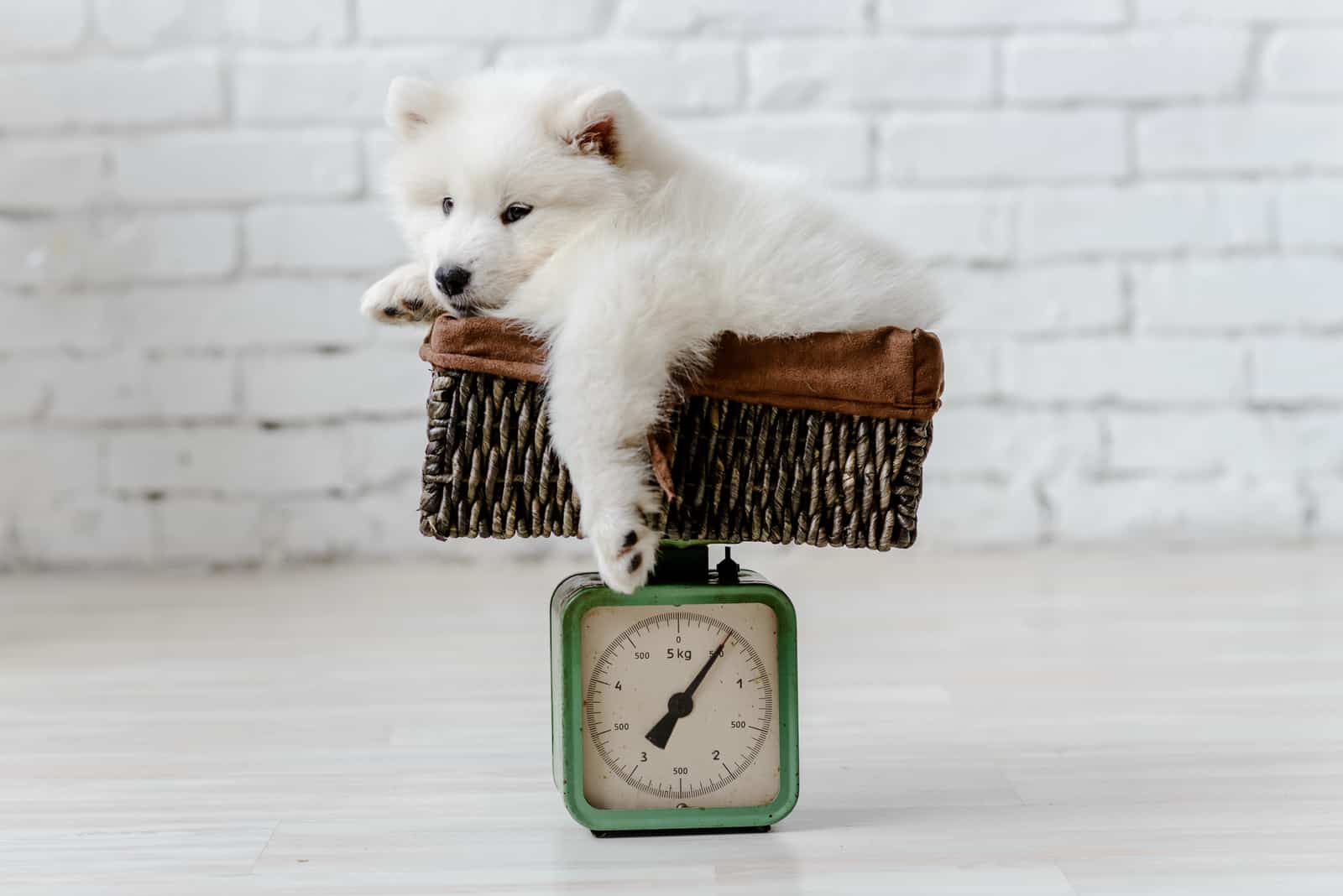Samoyeds are magnificent animals that will melt your heart every morning with their adorable look!
But, if you want your pup to stay healthy for a long time, you might need this Samoyed growth chart that can help you track your dog’s development.
While some people find the Samoyed to be a large canine, others claim that it’s a medium-sized pup.
According to experts, Samoyeds belong to the latter one because they usually grow up to 23.5 inches, while the minimum requirement for large breeds is at least 24 inches.
If you’re interested in the size of a Samoyed during its first two years of life, read this article and find out all the details regarding the Samoyed’s weight and height!
Samoyed Growth Chart: Male Vs. Female Weight Chart

Both male and female dogs are considered to be medium-sized, although male pups fall more on the heavier side.
The male vs. female Samoyed growth chart that is stated below shows you the ideal weight proportions that you should stick to for both genders.
Minor oscillations might occur, but if your pet is significantly under or over the average weight, you should react immediately:
[table id=401 /]
Samoyed Growth Chart: Male Vs. Female Height

Although they belong to the same breed, there are specific differences between Samoyed males and females (except for their gender, obviously), especially when it comes to their weight and height.
Male Samoyed pups tend to be larger than their female counterparts, with a height of up to 23.5 inches.
On the other hand, female canines can grow up to 21 inches maximum.
Therefore, it’s natural that their weight varies as well.
How Big Do Samoyeds Grow?
Considering that they’re already known as big canines, even though they belong to the medium-sized breed, Samoyeds can grow up to 24 inches in height when they reach full maturity.
However, it’s essential to keep in mind that dogs like Samoyed puppies take longer to reach their adult height and weight because larger canines develop in different ways.
Of course, there are general elements that might affect a puppy’s growth, including the well-being of the pup, its diet, and its training.
At the age of 24 months, Samoyeds should reach their full adult size. Some canines might get there by 18 months of age, but the majority take 18 to 24 months to reach the full size of an adult dog.
Samoyed Growth Chart: Puppy Development

The healthy development of Samoyed puppies is of great importance for their health in their adult years.
Essentially, almost all canines go through the same process of development, whether it is a small dog such as a Chihuahua (especially the teacup type), or a sled breed like a Siberian Husky or a Samoyed.
However, smaller breeds tend to grow faster than large breeds. Therefore, a Chihuahua will develop before a Boxer, and the same thing will happen between a Pug and a Great Dane.
Puppy growth charts are a great way to follow the development of your Samoyed pup. That way, you’ll be able to track any weight gain or weight loss as well as the height of the pup.
If your canine doesn’t seem to follow the developmental phases of its breed throughout the first year of its life, it would be a good idea to make an appointment with the vet and check the pup’s health.
Of course, the development phases described below are more of a rough estimate, and your pup might be a week behind or forward, but if it falls behind for more than a month, it would be better to consult an expert.
The First Two Weeks
Just like babies, Samoyed puppies spend this time eating and sleeping.
Deafness and blindness are completely natural during this period as the pups are born without hearing, vision, or teeth.
During this period, the mother is the main source of food, security, and comfort.
From Three To Twelve Weeks
Baby teeth begin to form at this period, which means that the pups are ready to try other types of dog food rather than mother’s milk.
This is the crucial time for socialization with people and animals. Early exposure of Samoyed pups to strangers and other pets during this period will benefit their mental health and social skills later in life.
This will be the period of fast development and the time when the puppy starts expressing its energy.
Breeders usually keep the pups at their premises until they’re eight weeks old, after which, the puppies become more independent and ready to move to their forever home.
Read More: 9 Samoyed Breeders In California – Find A Perfect Smiling Dog
Samoyeds should be dewormed and vaccinated during their seventh or eighth week of life.
From Four To Nine Months
Your Samoyed puppy is ready for a full training program at this point. Regular exercise is of the utmost importance for their health as it prevents undesirable weight gain that results in other health issues.
During this period, Samoyeds are starting to show their dominant side as they gain more confidence in themselves.
Spaying/neutering should be done by the sixth month of age as well.
From Ten To Eighteen Months
Congrats, your pup has become a young adult! Now’s the time to make diet plans for your pet and to maintain its healthy weight.
At this point, your pup is entirely ready for professional obedience programs and other practices that can help it become the best family pet!
Adult
Adulthood is usually the period where your pet has completely matured in every sense. At this stage, all variations in weight should be examined thoroughly to make sure that the canine is neither underweight nor overweight.
The best way to find out whether your dog has an ideal weight is described in the FAQ section of this article.
When it comes to mental abilities, it’s believed that Samoyeds acquire maturity up to the third year of life.
How to Weigh And Measure Your Samoyed

Weight
Considering that a Samoyed is a dog of medium size, determining its weight by using a scale designed for humans may be challenging for you, particularly if the dog is now or is getting near its mature size.
The following procedures can be carried out if you are physically capable of doing so or if your Sammie is in the early stages of life:
• Check your own weight and jot it down.
• Take the pet and stand on the scale. Write down this result as well.
• Subtract your weight from the mutual weight for the result.
Height
If you want to measure your Samoyed’s height at home, all you need is a measuring tape and a Samoyed pup.
Encourage your pet to stay in one place without moving or bending in order to get adequate measures.
Put the dog next to the wall and search for the withers that are placed in the upper middle of the back (between shoulder blades).
Put a narrow line on the wall so that it corresponds to the height of the withers. The height of your puppy may then be determined by taking the measurement from the floor up to the line on the wall.
FAQs

What Is The Average Size Of A Samoyed?
Essentially, the average size of this dog breed is the weight and height they get once they reach their adult years.
According to the breed standard that is accepted by some of the largest and most influential organizations, including the American Kennel Club (AKC), this dog breed is described as a medium-long canine, with a solid muscular frame and long white hair.
When it comes to height and length, we have already gotten used to male canines being larger than female ones.
However, the AKC states that female Samoyeds have more length in their body than their male counterparts.
Therefore, if you notice that your male Samoyed is shorter than the female pup on the Samoyed growth chart, there’s no need to fear as this is entirely natural.
Average Size Of Male Samoyeds
The majority of male canines will grow up to 24 inches in height, which is almost the same size as the crossbreed between German Shepherds and Border Collies.
Although they might be a bit shorter than female canines, male pups have a sturdier frame and more muscles, which is natural because they weigh more.
The adult weight of a Samoyed can be anywhere from 50 to 65 pounds, which is quite a broad gap, but I’d say that most male dogs weigh between 57 and 62 / 63 pounds.
Average Size Of Female Samoyeds
Female Samoyeds have a thinner physique and body shape than males, so it’s no surprise that they measure between 18 and 22 inches in height, and weigh from 40 to 50 lbs.
Most of these differences are truly minor, and they can’t be seen unless you measure a Samoyed every time you see one. However, one of the things that might immediately tell you which gender the canine belongs to is the frill on the neck, which is far less noticeable than in male pups.
Can Samoyeds Become Obese?
Samoyeds aren’t prone to obesity, generally, but that doesn’t exclude the fact that they might become overweight.
We can all agree that it’s difficult to set the bar for the right amount of food in every Samoyed’s meal.
Truth be told, most canine owners are in fear that their pets might be underfed if they don’t fill up the food bowl to the maximum.
Let’s be honest – our pets can be quite manipulative when it comes to food as well, but as an owner, you should stay strong and give only as much as your pet needs.
A well-balanced diet filled with vitamins and fibers will keep your dog far away from obesity.
Samoyeds are indeed larger dogs, which means that they might require portions closer to large breeds than medium-sized ones.
However, there’s a thin line between giving your large dog bigger portions just because it needs them or wants them.
How Do You Determine Whether Your Samoyed Is Underweight Or Overweight?
Keeping up with the ideal weight is challenging for canines because they can’t really tell you when they’re full. However, you might start noticing a particular pattern of eating that can tell you how much is enough.
In case you’re wondering why it’s so important to keep your pet within the average weight parameters, the answer is relatively straightforward – so they can live longer.
If you feed your pet right, a Samoyed’s lifespan might be increased up to two years, and I’m sure you’d do everything to make that happen.
There are several ways to determine whether your pup’s weight fits its age and musculature, such as weight calculators and Body Condition Systems.
Underweight Samoyeds
A Samoyed’s weight can be determined by feeling certain parts of its body or by using a dog weight calculator.
However, calculators depend on the growth chart set by individuals. Therefore, they might show you that your pet is underweight even if it’s not.
On the other hand, you can check whether your canine has a healthy weight without any numbers.
All you need to do is go over your dog’s ribs and focus on the thickness of the skin. If you can immediately feel the rib, that means that your pet needs a better-balanced diet.
Also, examine your pup from the front to the back. If you notice that it has little to no muscles or body fat, it is a possible sign that the canine is underweight.
Dog’s Behavior
Physical looks aren’t the only way for a dog owner to know that their pup is overweight.
Samoyeds usually have high energy levels, and they can spend hours playing outside without getting tired.
However, if their weight is under the estimated growth rate, certain behavioral changes might be visible.
If you notice that your pet has become lethargic, and that it has lost the will to do anything but lay down and sleep or stare at nothing, there’s a high chance that your pet is underweight.
However, this type of behavior might be a sign of other health conditions, which is why it would be better to consult a vet and do some health tests.
Healthy-Weight Samoyed
A healthy pup or an adult canine has the ideal weight if you feel muscles or a thin layer of body fat under its skin. It’s important to mention that the ribs should be felt under the fingers, but not as much as for underweight canines.
Once you examine your pup, confirm that the waist is visible, and that the underlayer of the skin is covered with a bit of fat and muscles, you can be sure that you have a perfectly healthy Sammy.
Adult males are usually more stocky than females, and they should have more muscles than body fat.
Healthy Pups
The Samoyed growth chart should be followed from early puppyhood, so you can follow your pet’s progress from the beginning.
Nutritious puppy food and regular exercise will ensure that your pet has the perfect puppy weight.
Overweight Samoyeds
If you are unable to locate the dog’s waistline when you look at it from above, it is highly likely that your pet is overweight. The same thing applies if the abdominal region is bloated or droopy.
Inspect the whole body by gently pressing the areas where the most fat appears (stomach, hips, neck, etc). If you can’t feel the bones, your furry companion definitely needs more exercise.
However, there’s no need to worry. Everyday walks in dog parks, along with physical activities throughout the day, can work wonders in combination with a healthy diet.
What Are The Most Common Health Issues In Samoyeds?

Unfortunately, just like the majority of purebred dogs, Samoyeds come with specific health problems that can be caused by genetics or lifestyle. Unfortunately, overweight canines have a higher risk of developing medical conditions that are stated below.
Of course, not every pup will suffer from these diseases, but it’s better to know the potential issues in time so that you can track your pet and react in time if you notice any symptoms.
You should be aware of a Samoyed’s health problems, such as:
• Diabetes Mellitus – This is a frequent illness among canines that strikes up to 1.3 percent of pups on a global level. It’s caused by a low level of insulin. Some of the most frequent symptoms are excessive thirst, eating, urination, and sudden loss of weight.
• Cardiovascular diseases – This dog breed has a higher risk of having cardiac issues such as the atrial septal defect, mitral valve disease, and subaortic stenosis (genetic issue).
• Hip dysplasia – This is a widespread health condition that occurs during the first months of a pup’s life, although the majority of owners can’t notice the first symptoms until adulthood. All parts of the joint are supposed to grow at the same rate, and if they don’t, diseases such as osteoarthritis might appear.
• Alopecia X – This is one of the most common conditions that causes coat fur loss. However, one of the good things about it is that this is only an aesthetical condition, meaning that it doesn’t affect your canine’s health.
• Hypothyroidism – This disease generally happens when the Samoyed’s thyroid doesn’t create vital thyroid hormones in the amount that is needed for normal functioning. This condition results in sluggish metabolism, which is the main culprit of excessive weight.
• Eye issues – Although they generally don’t have vision problems, some Samoyed’s might develop eye diseases such as Progressive Retinal Atrophy (PRA), cataracts, glaucoma, etc. If you notice that your pet is looking the wrong way when you call him or can’t find his food bowl if you move it a bit, it’s time to call the vet.
What Is The Average Life Expectancy Of A Samoyed?
Samoyeds can live up to 15 years, which is quite long for a canine, but only under certain conditions.
Most owners are concerned about their pet’s health and lifespan if they’re owerweight, but an underweight canine is just as unhealthy as an obese one. Your pet’s life can be significantly shortened in both cases because unhealthy weight causes other health issues that affect a Samoyed’s life expectancy.
A well-balanced diet and physical activities are the base of a long life. If you take good care of your pet, you might even expand its life for an additional 24 months!
Unfortunately, things like its genetic background and illnesses can shorten its lifespan significantly, but these aren’t things that we can have an impact on.
This clearly shows that having a pet isn’t just fun and games – it’s also a serious responsibility.
Are Samoyeds Expensive?
Even though they’re not very common, Samoyeds are actually more on the inexpensive side. The price of a purebred Samoyed can go up to $3000 if it’s a champ, or $1400 for a regular purebred doggo from a reputable Samoyed breeder.
Samoyeds might be low-priced when it comes to the initial cost, but the expenses of keeping one can be quite high, especially if you want your pet to live a healthy life.
A well-balanced diet includes highly nutritious food that might be costly, but nothing can cost more than your pet’s life, right?
No one can put a price on their pet’s health and happiness, which is why most Samoyed owners don’t regret spending more money on their furry friends.
Samoyed Growth Chart: Wrapping Up

A Samoyed growth chart is a great way to follow your pup’s development. This is important because any unnatural change in your canine’s weight or height might be a sign of an underlying issue.
It’s impossible to keep track of all of the symptoms of all diseases, but it’s much easier when you know that growth development can show the majority of issues related to your Samoyed.
Nutritious food is an integral part of a canine’s health, and the right amount is up to the owner to decide.
I’m sure that you’re taking great care of your Samoyed, and I hope that this article will help you track the health state of your pup as well!
READ NEXT:
Are Samoyeds Aggressive? Unpacking The Samoyed Character
50+ Cute And Popular Samoyed Names – Adorable Name Ideas
